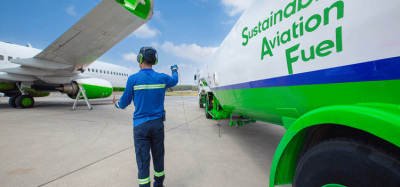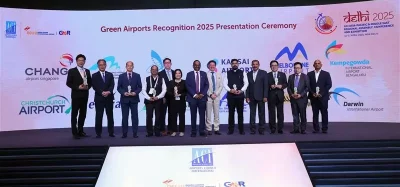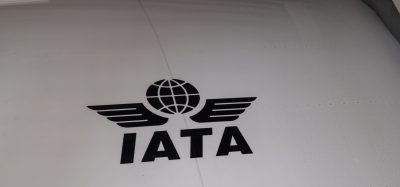Operations and fuel conference report
- Like
- Digg
- Del
- Tumblr
- VKontakte
- Buffer
- Love This
- Odnoklassniki
- Meneame
- Blogger
- Amazon
- Yahoo Mail
- Gmail
- AOL
- Newsvine
- HackerNews
- Evernote
- MySpace
- Mail.ru
- Viadeo
- Line
- Comments
- Yummly
- SMS
- Viber
- Telegram
- Subscribe
- Skype
- Facebook Messenger
- Kakao
- LiveJournal
- Yammer
- Edgar
- Fintel
- Mix
- Instapaper
- Copy Link
Posted: 10 June 2005 | John Armbrust, President, Armbrust Aviation Group (AAG) | No comments yet
Highlights of the agenda at the most recent International Airport Operations/Jet Fuel Conference at Orlando, Florida included talks on fuel delivery infrastructure problems, ramp safety and Common Use Ramp Equipment.
Highlights of the agenda at the most recent International Airport Operations/Jet Fuel Conference at Orlando, Florida included talks on fuel delivery infrastructure problems, ramp safety and Common Use Ramp Equipment.
Sponsored and organised by the Armbrust Aviation Group, the event was the seventh to have taken place. Held on three days, February 2-4th, it attracted attendees from all over the globe and did not disappoint those airport managers looking for intelligent industry debate and predictions. The conference ran concurrent to an exhibition that hosted many relevant exhibitors and provided networking opportunities and working sessions.
On the first day the show played host to the Airport Operations Safety Panel (AOSP). The AOSP is a group of industry figures who gather to discuss the current state of operational safety in airports. Through identifying areas of concern, seeking solutions and making recommendations, the panel raises awareness of important issues. The general session of the conference was then split into two sessions, the first of which saw the members of the AOSP report to the conference on the results of its industry survey and the second of which covered the issues associated with jet fuel prices. Both sessions saw debate crystallise into shared opinion and comments formulate into plans for future action.
Reporting safely in the future
Many in the industry currently view airside safety as an expensive and growing problem. Ramp area accidents are on the rise and it is the responsibility of airlines, airports and ground handlers to control the situation. John Pallante, senior associate for Booz Allen Hamilton, specialists in aviation and safety, acknowledged that ramp safety has been an issue for several years, particularly with increasing ramp congestion and tighter turn times for aircraft. Cost he believed, should be spurring people to action: “Most of us involved in the safety business have to struggle between balancing the goals of operational safety and the cost to the company,” he added: “Incidents are up around the world. Costs are up and we know injuries are up.”
According to Pallante a key problem is the lack of a central repository for reporting and analysing incidents. He called for airports to take the lead in addressing the problem, but without regulation. “The airport authorities have traditionally leaned towards a hands-off approach to those leased ramp areas, yet airports have the highest potential for making a difference, if they take the responsibility for and develop a safety culture,” he concluded.
One of Pallante’s colleagues from Booz Allen Hamilton supported this view. John Saams pointed out that the stakeholder approach to ramp operations often means that non-movement areas are unregulated. Safety standards, he claimed, need to be comprehensive and consistent. “You can’t manage safety by committee,” Saams said, “somebody has to take charge.”
He contended that a reporting policy would help all the parties identify and solve problem areas. Furthermore he claimed that incentives, such as rewards for reaching a certain number of accident-free days, only serve to suppress reporting. “The more information you get the more you can analyse it, trend it and make corrective action. Ultimately you don’t want to have to withstand reactive regulation in this industry.”
Common use of ramp equipment
Utilisation of equipment was also a topic widely discussed on the operations side. Scott Simpson, AviaEd, when discussing Common Use Ramp Equipment (CURE) noted that although allocating equipment is feasible at smaller airports, it may become too complicated at larger hub airports. He cited the benefits of CURE as including the tidying up of the ramp area and the relief of congested areas. However he also noted that potential problems may exist with maintenance and ongoing costs. “If you have equipment that is shared by different carriers, who owns that piece and who pays for its maintenance or repair? If it is damaged who investigates and who ultimately pays? Who pays for the fuel needed to move it to various places on the ramp?”
Natalie Wolf, senior executive, Fraport Ground Services USA, added that CURE could be of benefit at certain airports. “I agree that we all have to look at ways to make the best use of diminishing resources and increase the efficiency out there, but I also want to stress that it shouldn’t be argued that a loss of quality comes with it,” Wolf said. She equated time performance with a tight control on procedures on the ramp and pointed to airports such as Amsterdam Schiphol, London Heathrow and Paris Charles de Gaulle, which have several ground handling companies each and delay rates far higher than at Frankfurt.
On the theme of integrated services, Mark Sapp, director, Air IT, made the case for integrated information systems, which would be of particular importance in a common use situation. An airport operations database, he said, could solve such issues as a lack of a central repository for reporting accidents and allow for the allocation of resources according to changing dynamics. Sapp said: “It gets down to the same thing; using more of your facility by being able to generate 20-30, maybe even 40 per cent more effective utilisation because you had the information you needed.”
A380 considerations
The impact of the A380 was also an issue raised at the Conference (Ed: Dr Thilo Stilp gives Airbus’ side of the ground handling story to IAR on pg 17). Johnathan Howe, executive vice president, Farragaut International, explained the challenges the aircraft may have at various airports, but also sought to dispel the myth that major readjustments were needed to accommodate the plane. Although JFK and LAX are both making extensive modifications, Howe said, the changes were “driven primarily by non-A380 considerations.”
“Probably the biggest issue with respect to this aircraft is not on the airside at all but on the passenger handling side,” he said. The aircraft could also cause considerable congestion in the ramp area, he admitted. “…the gate areas will have to be carefully selected with respect to the adjacent gates. In most cases it will not be possible to have more than a DC9 or a 737 parked at the adjacent gate. This is terminal specific. There will be some terminals where it will not be possible to taxi the aircraft up to the gate – it will be a tow in situation.”
Fuel supply infrastructure and pricing
The Jet Fuel session of the conference provided a useful forum for the discussion of the key concerns and challenges for those involved with this aspect of the business. Infrastructure concerns topped the bill of the first session and the recent crisis at Washington Dulles International (IAD) was spotlighted.
Dick Detois, executive director of the Metropolitan Washington Airlines Committee, which represents airlines to the airport authority, said that the airport’s current infrastructure was currently unable to handle the growing demand there. The situation came to a head last summer at IAD when Independence Air launched with 300 flights per day and United Airlines expanded its schedule. The airport authority became involved because of its concern over meeting current needs and the ability to expand. The short term fix was supplemental trucking of fuel, along with other measures intended to minimise shortages. The long term solution will involve developing the infrastructure.
According to Robert Sturtz, director of petroleum and purchasing, United Airlines, the problems are not limited to IAD. He indicated that several airports have potential capacity problems, including IAD and Denver International. He also commented that factors such as increased demand, a continuing focus on reducing working capital and inventories and the inexperience of new staff who are responsible for infrastructure and scheduling are exposing weaknesses in the system. “The result of all of these things is that we’re experiencing increasing vulnerability to run outs and price spikes,” he said.
Justin Walker, aviation manager for Air BP, stated that the oil companies’ capital considerations were permanent and signalled a new direction for the business. He also said that jet fuel infrastructure in much of the US is 50 years old and in need of upgrade and expansion. However, investment from industry was proving difficult to obtain. “Approval is difficult to obtain, it takes long waiting periods and the regulatory requirements and environmental [requirements] are pushing up the costs,” he said. Sometimes condemning a facility was a more viable option than upgrading, he commented.
A further Jet Fuel session, entitled ‘Surviving in a High Price Environment’ saw experts weigh in as to what can be expected in the coming months with regard to fuel prices and the related infrastructure constraints. John Heimlich, economist with the Air Transport Association of America, noted that the industry had experienced widening cracks in the past several months. He also noted that carriers had been unable to recoup higher expenditure on fuel. “There is a complete lack of pricing power in the US revenue environment,” he said. “The carriers have not been able to pass costs onto passengers.”
Daniel Massey president of Argus Media, meanwhile noted that the supply-demand balance that existed in the past had been upset by increased Chinese demand for oil. Increased global demand, he said, “makes us more vulnerable to foreign supply disruption.” The situation is exacerbated by inadequate infrastructure throughout the US and that despite the need for improvement, it still doesn’t make sense for oil companies to invest in infrastructure. “The equity markets are not rewarding the oil companies for investing in infrastructure,” Massey said.
Micheal Burdette, senior analyst at the US Department of Energy, brought to the discussion the predictions from his department, the petroleum division. “We don’t see jet fuel prices going much higher,” he said. “We think they’ll stay at about $1.20 cents per gallon, which isn’t much comfort I realise, but is better than $1.50 cents.” On supply infrastructure, Burdette recognised the uncomfortable situation in the US. “There is not a refiner out there who is thinking about jet fuel when he decides to run his refinery.”
Conclusions
The conference brought to light many of the concerns about safety on the ramp and also put forward some individual solutions from airports and ground handlers. But there is still much ground to be covered and there is increasing pressure on the industry to focus attention on these issues. The roles of various industry sectors, the viability of CURE, training and prevention methods and other aspects relating to ramp safety will be explored in depth in the coming months as the industry attempts to tackle this growing problem.
Regarding fuel, the conference brought to the fore many of the current issues and challenges facing the industry and dealt with possible solutions.

















